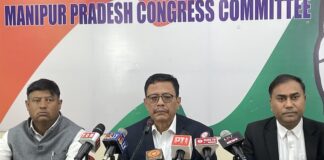Shillong: The Meghalaya government has constituted three regional committees to resolve boundary disputes in six remaining ‘areas of differences’ with Assam, an official said on Monday.
Out of 12 ‘areas of differences’, Meghalaya Chief Minister Conrad Sangma and his Assam counterpart Himanta Biswa Sarma signed a Memorandum of Understanding (MoU) in the presence of Union Home Minister Amit Shah resolving the differences in a 36.79 sq km area comprising six (Tarabari, Gizang, Hahim, Boklapara, Khanapara-Pilangkata and Ratacherra) in the first phase.
The three regional committees will examine the present status of the remaining six ‘areas of differences’ viz., Langpih in West Khasi Hills District; Borduar, Nongwah- Mawtamur, Deshdoomreah, Block-ll in Ri-Bhoi District; Block-l, Psiar-Khanduli, a notification issued by Chief Secretary Donald Philips Wahlang stated .
While the six-member committee for Ri-Bhoi district is headed by Deputy Chief Minist Prestone Tynsong as chairman, the committee for West Khasi Hills is headed by Public Health Engineering (PHE) minister Renikton L Tongkhar and the committee for West Jaintia Hills is headed by Urban Affairs Minister Sniawbhalang Dhar, together with Home Minister Lahkmen Rymbui, and other members.
The committees are mandated to coordinate with the relevant regional committee set up by the Assam government, establish the geographical location of the villages, their contiguity and examine population including ethnicity.
The committees would visit each of the villages, and interact with the communities living in the villages including the elected representatives of the Autonomous District Councils and other stakeholders to learn about the perception of the people living in the area.
The committees would document the factual information regarding the physical and time-wise distances from the villages to the nearest public service delivery point administrative unit.
The committees will submit their report to the Meghalaya government within a period of 45 days from September 26,2022.
Based on the inspection of the villages and agreed yardsticks of historical perspective, ethnicity of the local population, administrative convenience of local people, contiguity with the boundary and the perception of the people living in the area, the reports would be formulated and submitted.


